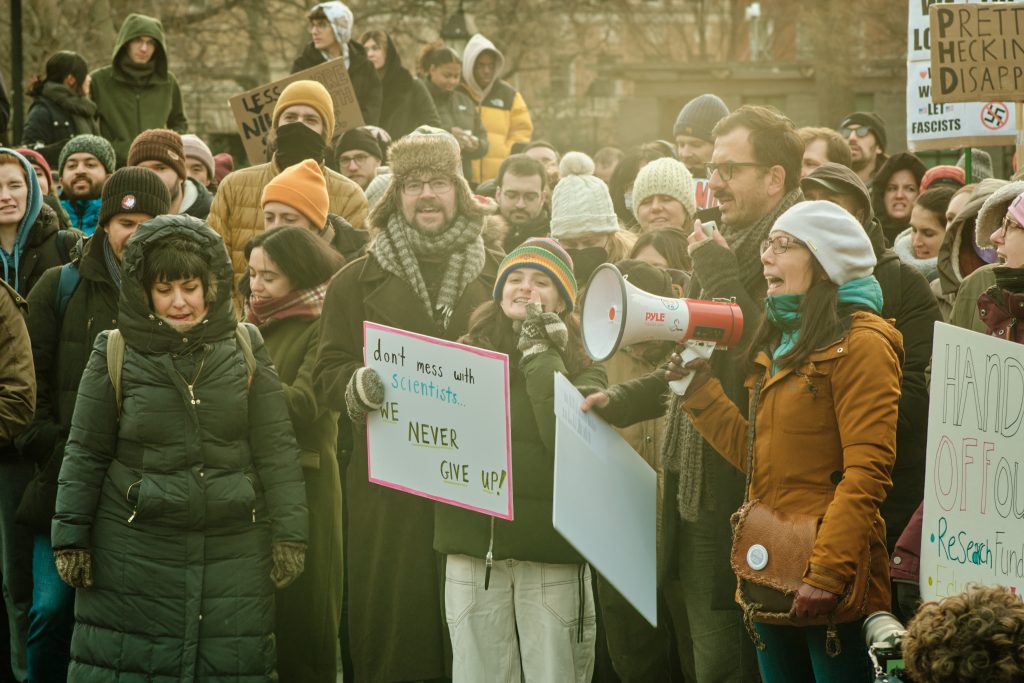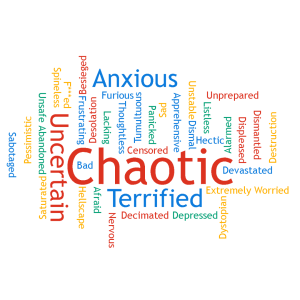The contentious 2024 U.S. presidential election has had a resounding impact on the social state of the U.S. and broader communities. In a country that seems to be more divided every day, fueled by rhetoric from both sides of the aisle, it is difficult not to question what effect the political environment will have on my care
er as an emerging scientist. Once the election was called in Trump’s favor, the main question that kept popping into my mind was, “How will this affect the science community on top of other aspects of American life?”
To understand how recent political trends have impacted scientific research, I met with Andy Koff, PhD, a senior faculty member at Memorial Sloan Kettering Cancer Center who has been working at the institution for over thirty years. When asked how he has seen science change over his career due to politics, Koff responded, “Science used to be supported by both sides of the aisle. However, during the most recent Republican administrations, science has lost respect and support.” When I took a deeper look at the swinging pendulum of support for science between the more recent U.S. presidential administrations, this clear and pointed statement proved to be unmistakably true.
Looking Back
Although there was an increase in funding for biomedical research and development (R&D) during the Bush administration, there is a plethora of press releases, articles, and publications detailing President George W. Bush’s scrutiny and control of federally funded scientists and fields of study during his two terms. For example, federal funding for stem cell research was substantially restricted in 2001, when Bush announced that the National Institutes of Health (NIH) would only fund projects using existing stem cell lines. Additionally, the Bush administration was known for blocking federal scientists from attending international meetings, including World Health Organization meetings, through changes in Notice of Foreign Travel filings. Bush also stacked scientific advisory councils with “individuals with the right religious or philosophical pedigrees,” according to Dr. Torsten Wiesel, former president of Rockefeller University.

When President Obama took office in 2009, he adopted a starkly different approach to scientific research. Early into his first term, the White House released the “Strategy for American Innovation,” which created a policy architecture for translating R&D results into long-term national prosperity. This involved increasing access to STEM education and promoting collaboration between private and academic research sectors, which ultimately led to increased economic growth and innovation. The Obama administration also oversaw the development of scientific integrity policies across government departments and agencies to allow for transparency and improve the availability of data produced by federal institutions. Obama continued to push for increased federal spending on R&D throughout his two terms and signed the 21st Century Cures Act at the very end of his presidency in 2016 to provide biomedical R&D with billions of dollars in new funding. Surprisingly, though, the National Science Foundation reported that the amount of federal funding for university research declined by almost 13% between 2011 and 2015 (adjusted for inflation).
“Science used to be supported by both sides of the aisle. During the most recent Republican administrations, it has lost respect and support.”
Following the Obama administration, we witnessed a decrease in federal funding for science and technology research during President Trump’s first term. For example, in his first budget submitted to Congress in June 2017, Trump called for an 18% and 17% reduction of funding to the NIH and CDC, respectively. He also proposed a 31% decrease in federal funding for the Environmental Protection Agency. When asked to explain the steep cuts, Mick Mulvaney, the head of the Office of Management and Budget, quickly replied, “We’re not spending money on that anymore.” Although these massive cuts were not fully implemented in the 2018 budget approved by Congress, the negative rhetoric against leading federal science agencies persisted throughout Trump’s first term.

A key element that made Trump’s dismissal of scientific advice different from Bush’s actions was the use of social media. In the early 2000s, the U.S. public had to wait for press releases or official orders from Bush to gain insight into his views on scientific research. But in the digital age, President Trump was able to quickly broadcast his often misinformed views to his millions of followers on Twitter (now X). This further eroded public confidence in the scientific community during the COVID-19 pandemic.
In addition to making optimistic, unfounded claims about COVID-19 spread and control, the Trump administration took multiple actions to limit any CDC messaging about COVID-19 that contradicted President Trump’s public statements. These actions included reviewing CDC weekly pandemic updates before public release, adding caveats to CDC reports, and reprimanding federal scientists for speaking without approval.
In contrast to Trump’s restriction on CDC communication, Biden, his presidential successor, promised to “choose science over fiction.” During the Biden administration, Dr. Anthony Fauci, the former Director of the National Institute of Allergy & Infectious Diseases, openly spoke out against censorship by the previous administration and described working with Biden as “a refreshing experience.” During Fauci’s thirty-eight years of service, he had never before experienced anything like Trump’s dismissal of scientific advice in favor of quick promises to political supporters. This common sentiment has been expressed by individuals from all parts of the government and is concerning as we brace for the next four years under Trump.
Science Under the Second Trump Administration
The speed and force with which the new administration under Trump is moving to control federally funded scientists is something we have not witnessed before. The feeling of uncertainty I experienced in November was amplified during President Trump’s first 100 hours in office as he froze the disbursement of federal grants, halted NIH and other science agencies’ communications, and struck down federally funded DEI initiatives.
Several federal judges and state attorneys general throughout the country are fighting against most of the administration’s executive orders, including the proposed limit on indirect costs for NIH-funded grants. To taxpayers unfamiliar with NIH funding, limiting “indirect costs” might sound like a viable option to reduce government spending. However, indirect funding provides much-needed support for equipment and facility maintenance, without which research cannot happen.
The ripple effects of writing off different aspects of research as a waste of money will dismantle the American scientific community, which, as a whole, has already experienced a decrease in federal funding (compared to GDP) since the 1980s. The collaboration between government, academic, and private research labs made America great and drove scientists from other countries to come to the United States. Technology has changed society as we know it—for example, computers grew out of government-funded academic labs, and private companies later brought that technology to the public. As federal funding for research decreased, entities from the private sector, such as pharmaceutical companies, filled in the gap. This shift from federal to private funding arguably created a foundation for private corporations to take a key role in research by deciding which projects were deserving of funding. The Koff paradox, outlined by Yuri Lazebnik in 2018, reveals how this shift to a more profit-driven research mentality can lead to less innovation.
“How can a market exist for that which is yet to be discovered? How can a market signal a need for something that is unknown to exist and impossible to foresee? It cannot. That is the very problem with the majority of science today… it lacks creativity, but rather fills in details that have market value.” – Koff paradox
As an example, mRNA vaccine development, which was essential during the COVID-19 pandemic, was one of the many projects that initially fell by the wayside due to a lack of commercial interest. Drs. Katalin Karikó and Drew Weissman’s work developing mRNA vaccine technology showed promise as early as 2005. Due to the lack of a functional product at the time, however, there was little private interest in continuing mRNA vaccine research. The race to develop safe and effective vaccines against COVID-19 rekindled interest in mRNA vaccine research, with Pfizer’s mRNA COVID vaccine becoming the first to receive FDA approval. Now, researchers are applying mRNA vaccine technology to other diseases, such as HIV. We will probably never truly understand the breadth of loss in innovation due to the lack of federal support for basic research and the commercialization of science.
Reactions in the Tri-I

To gauge how the results of the 2024 U.S. election are affecting scientists in the Tri-I community, including technicians, graduate students, and faculty, I created a four-question poll that was live during February 2025. Out of forty-seven Tri-I members who answered the poll, thirty respondents said that the results of the 2024 U.S. presidential election affected their career goals. When further asked how their career goals had changed, respondents highlighted the lack of support for academic research and a decrease in safety for minorities. Several responses indicated that the uncertainty surrounding government funding for postdoctoral positions and academic research is pushing them to consider careers in the private sector or other countries. One of the respondents remarked that the social and political state of the U.S. has made the research job market precarious. They noted that the current administration’s targeting of minorities has made them think twice about living in the U.S. and speculated that cuts to federal research funding might produce an oversaturation of applicants for private-sector research jobs, which have already seen major layoffs in the past couple of years. “If the democratic backsliding of the U.S. continues, should I even try to start my career here?”
57.4% of respondents said that they are considering looking for jobs outside of the U.S. due to the current presidential administration. Almost 90% of respondents indicated that they do not feel supported by the Trump administration. When asked to describe the state of the U.S. science community in one word, most words used were negative, from frustrated to dystopian, while the most repeated word was chaotic.
I sat down with a third-year PhD candidate from Weill Cornell, who wished to remain anonymous, to further discuss how the current U.S. presidential administration is affecting their life. “After experiencing the start of a Trump term [in 2017],” they said, “I felt that I was going to be prepared…as a more aware adult, it is still shocking.” They noted that the constant bombardment of negative headlines can overwhelm people and discourage them from participating in political discussions. They also highlighted the many “smaller changes… being made,” such as the potential privatization of the U.S. Postal Service and dismantling of other federal agencies, “that will have a greater impact on our lives.”
The student indicated that although they already knew they didn’t want a career in academia, they have noticed increased stress on their friends and peers who are pursuing careers in academia. “With all the uncertainty in funding, people that were passionate about being principal investigators (PIs) lost some of that fire,” they observed. Freezes and drastic funding cuts can impair an individual’s ability to obtain grants that are essential to their career progression if they hope to land a PI position. “I can see how frustrated people are because of all these things that are completely out of their control,” the student stated. They noted that meetings to discuss many grant applications have been canceled due to Trump’s executive orders, which has added a new level of difficulty to the process of obtaining a grant. Although the current state of the American science community seems bleak, it is important to take action and bring attention to the devastating long-term effects of these cuts and freezes.
“I fear I will need to drastically change careers, as academic science may be a thing of the past.” (Anonymous survey response)
Where Do We Go From Here?
One way the graduate student I interviewed is trying to combat the changes implemented by the Trump administration is by becoming more involved on the local level. Because local politicians represent fewer people, they are motivated to put more energy towards the issues that matter to their constituents to get reelected.

Credit: Valerie Gallegos
Other members of the Tri-I community have taken action by attending protests, including the local Stand Up for Science protest that took place on March 7. Stand Up for Science was organized by many scientists across the U.S. to urge President Trump to expand funding for scientific research, put a stop to the freezing of federal research grants, and reinstate federal scientists. Many scientists and medical professionals have taken to social media to combat misinformation and censorship from the Trump administration—for example, by sharing public health information while federal science agencies were under communication freezes.
Persistence, overcoming challenges, and finding new approaches are at the core of scientific life. While I am staunchly against the current U.S. presidential administration’s targeted attack on science, I am hopeful that we will overcome this chapter in American history. As these next four years unfold, how will you fight for the science community?

